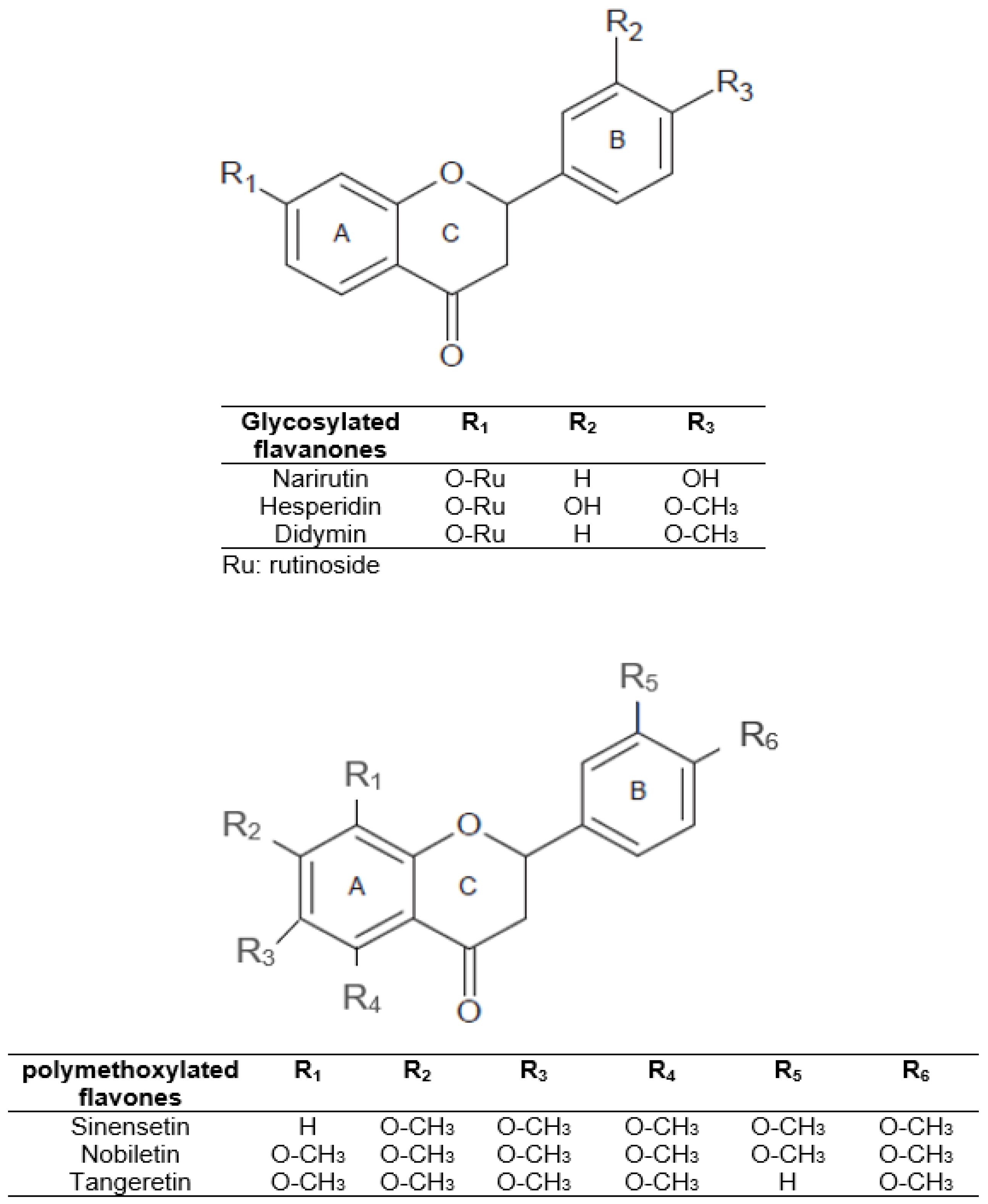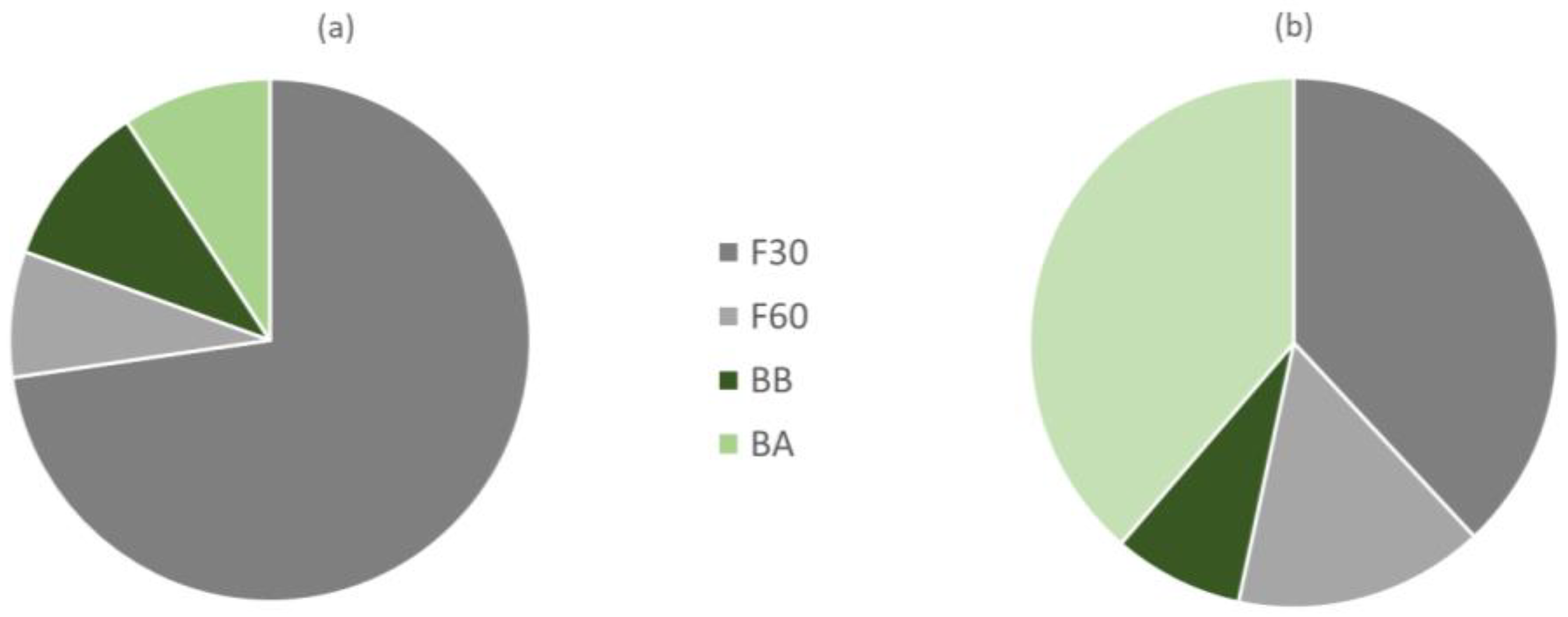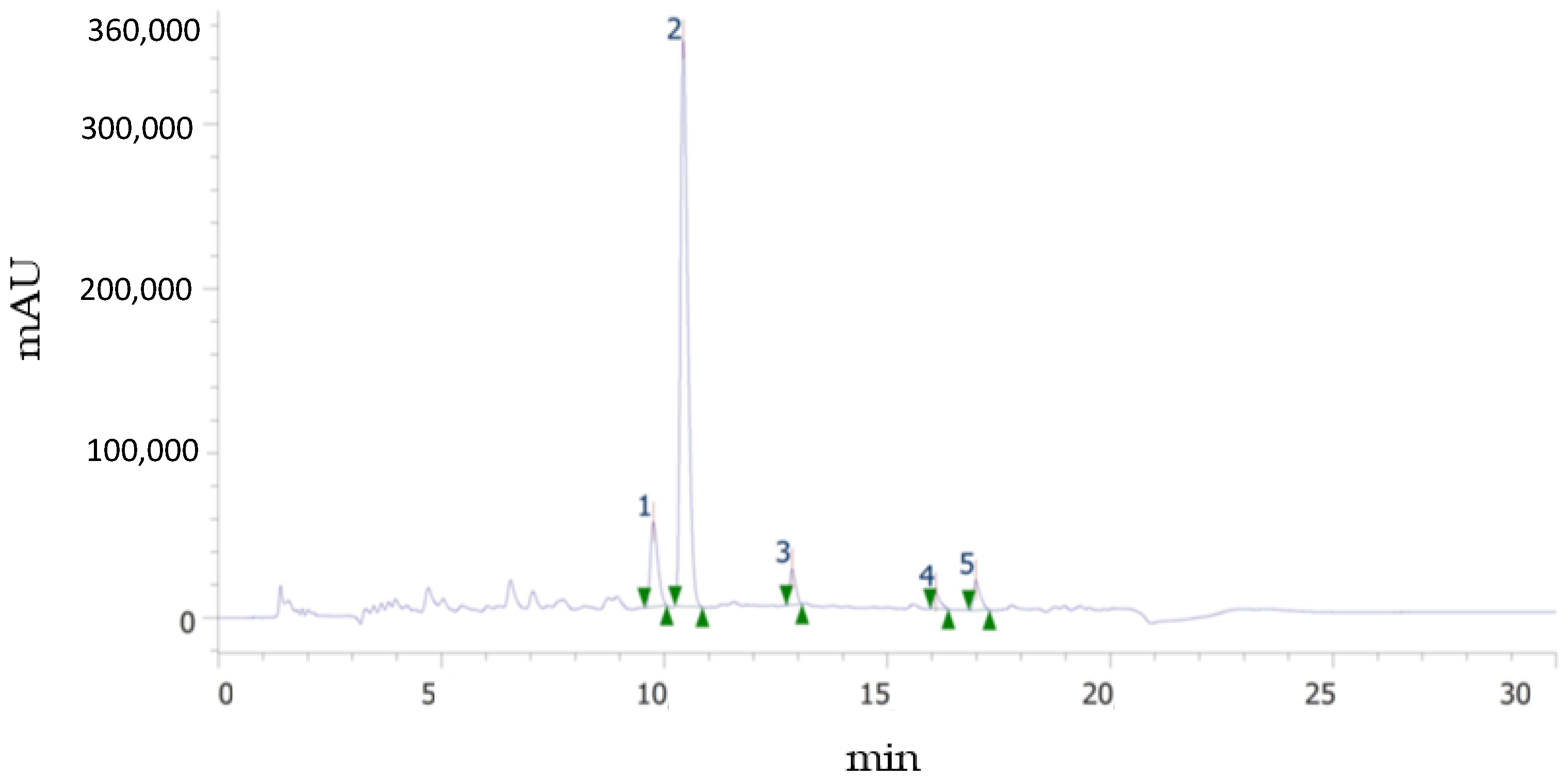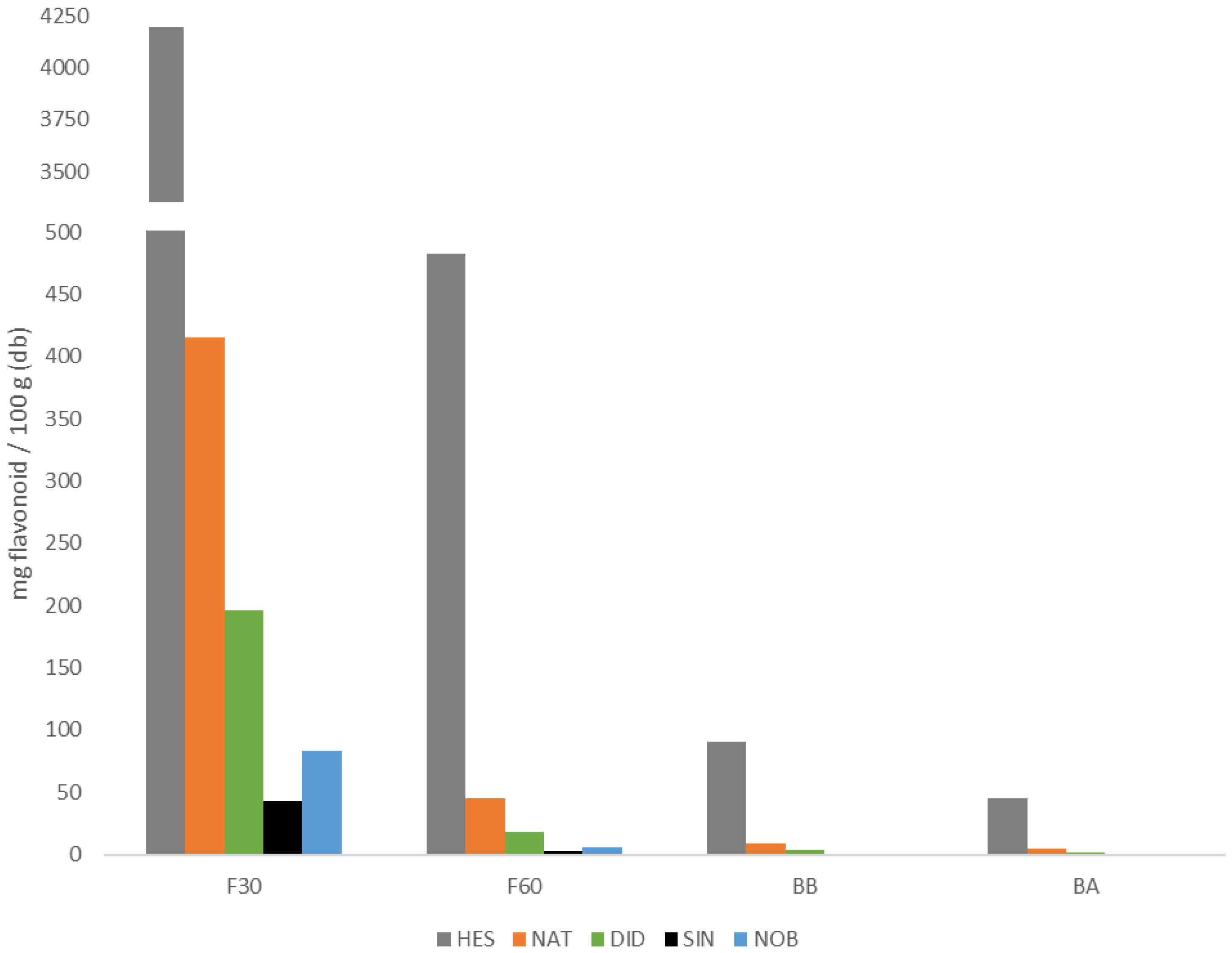Free and Bound Phenolic Compounds Present in Orange Juice By-Product Powder and Their Contribution to Antioxidant Activity
Abstract
:1. Introduction
2. Materials and Methods
2.1. Obtaining the Orange Juice Powdered By-Product
2.2. Extraction of Free and Bound Phenols
2.3. Analysis of Phenolic Extracts
2.4. Statistical Analysis
3. Results
3.1. Total Phenolic Compounds
3.2. Main Flavonoids
3.3. Antioxidant Activity
3.4. Statistical Correlations
4. Discussion
Author Contributions
Funding
Institutional Review Board Statement
Informed Consent Statement
Data Availability Statement
Acknowledgments
Conflicts of Interest
References
- Afam, I.O.J.; Henry, S.; Thakhani, T.; Adewale, O.O.; Henry, O.U.; Tonna, A.A. Antioxidant-rich natural fruit and vegetable products and human health. Int. J. Food Prop. 2021, 24, 41–67. [Google Scholar] [CrossRef]
- Quiñones, M.; Miguel, M.; Aleixandre, A. Revisión Los polifenoles, compuestos de origen natural con efectos saludables sobre el sistema cardiovascular. Nutr. Hosp. 2012, 27, 76–89. [Google Scholar] [CrossRef] [PubMed]
- Brglez-Mojzer, E.; Knez-Hrnčič, M.; Škerget, M.; Knez, Ž.; Bren, U. Polyphenols: Extraction Methods, Antioxidative Action, Bioavailability and Anticarcinogenic Effects. Molecules 2016, 21, 901. [Google Scholar] [CrossRef] [PubMed]
- Arturo-Calvache, J.E.; Ramírez-Delgadillo, C.J. Evaluación de la Extracción de Flavonoides a Partir de la Cáscara de la Naranja. Ph.D. Thesis, Fundación Universidad de América, Bogota, Columbia, 2020. [Google Scholar]
- Asqui-Quishpe, M.A.; Cortez Pérez, A.A. Efectos de la Liofilización en la Actividad Antioxidante del Arazá (Eugenia Stipitata Mcvaugh). Ph.D. Thesis, Universidad de Guayaquil, Guayaquil, Ecuador, 2022. [Google Scholar]
- Trueba, G.P.; Sánchez, G.M. Los Flavonoides como Antioxidantes Naturales. Acta Farm. Bonaer. 2001, 20, 297–306. [Google Scholar]
- Vierci-Bravard, G.E.; Ferro-Bertolotto, E.A. Capacidad antioxidante total vinculada a la ingesta de vegetales en adultos jóvenes de Asunción, Paraguay. Nutr. Hosp. 2018, 36, 118–124. [Google Scholar] [CrossRef] [PubMed]
- Department of Agriculture, Agricultural Research Service. Oxygen Radical Absorbance Capacity (ORAC) of Selected Foods, Release 2. Nutrient Data Laboratory, 2010. Available online: https://www.orac-info-portal.de/download/ORAC_R2.pdf (accessed on 27 July 2022).
- de Moraes-Barros, H.R.; de Castro-Ferreira, T.A.P.; Genovese, M.I. Antioxidant capacity and mineral content of pulp and peel from commercial cultivars of citrus from Brazil. Food Chem. 2012, 134, 1892–1898. [Google Scholar] [CrossRef]
- Singh, B.; Singh, J.P.; Kaur, A.; Singh, N. Phenolic composition, antioxidant potential and health benefits of citrus peel. Food Res. Int. 2020, 132, 109114. [Google Scholar] [CrossRef]
- Ballistreri, G.; Fabroni, S.; Romeo, F.V.; Timpanaro, N.; Amenta, M.; Rapisarda, P. Anthocyanins and other polyphenols in citrus genus: Biosynthesis, chemical profile, and biological activity. In Polyphenols in Plants, 2nd ed.; Academic Press: Amsterdam, The Netherlands, 2019; pp. 191–215. [Google Scholar]
- Koolaji, N.; Shammugasamy, B.; Schindeler, A.; Dong, Q.; Dehghani, F.; Valtchev, P. Citrus peel flavonoids as potential cancer prevention agents. Curr. Dev. Nutr. 2020, 4, nzaa025. [Google Scholar] [CrossRef]
- Arranz-Martínez, S. Compuestos Polifenólicos (Extraíbles y No Extraíbles) en Alimentos de la Dieta española Metodología Para su Determinación e Identificación. Ph.D. Thesis, Universidad Complutense de Madrid, Madrid, Spain, 2010. [Google Scholar]
- Ajila, C.M.; Prasada-Rao, U.J.S. Mango peel dietary fibre: Composition and associated bound phenolics. J. Funct. Foods 2013, 5, 444–450. [Google Scholar] [CrossRef]
- Antolovich, M.; Prenzler, P.; Robards, K.; Ryan, D. Sample preparation in the determination of phenolic compounds in fruits. Analyst 2010, 125, 989–1009. [Google Scholar] [CrossRef]
- Grande-Tovar, C.; Araujo Pabón, L.; Flórez López, E.; Aranaga Arias, C. Determinación de la actividad antioxidante y antimicrobiana de residuos de mora (Rubus glaucus Benth). Inf. Técnico 2020, 85, 64–82. [Google Scholar] [CrossRef]
- Herrera, R.Q.; Carlos, J.; Ferrel, B.; Solís, H.Q.; Paredes-Valverde, Y.; Cahuana-Mamani, P.; Ángel, M.; Coral, V.; Contreras, W.C. Antioxidant capacity of Ungurahui nectar (Oenocarpus bataua). Nutr. Clin. Diet. Hosp. 2022, 42, 80–86. [Google Scholar] [CrossRef]
- Solomakou, N.; Loukri, A.; Tsafrakidou, P.; Michaelidou, A.M.; Mourtzinos, I.; Goula, A.M. Recovery of phenolic compounds from spent coffee grounds through optimized extraction processes. Sustain. Chem. Pharm. 2022, 25, 100592. [Google Scholar] [CrossRef]
- Dai, J.; Mumper, R.J. Plant Phenolics: Extraction, Analysis and Their Antioxidant and Anticancer Properties. Molecules 2010, 15, 7313–7352. [Google Scholar] [CrossRef] [PubMed]
- Valdés-Hernández, G.V.; Cruz-Viera, L.; Comet-Rodríguez, R. Influence of operating conditions on the extraction of polyphenols from Moringa Oleifera Lam leaves. Rev. CENIC Cienc. Quím. 2015, 46, 135–145. [Google Scholar]
- Alu’Datt, M.H.; Rababah, T.; Alhamad, M.N.; Al-Mahasneh, M.A.; Ereifej, K.; Al-Karaki, G.; Al-Duais, M.; Andrade, J.E.; Tranchant, C.C.; Kubow, S.; et al. Profiles of free and bound phenolics extracted from: Citrus fruits and their roles in biological systems: Content, and antioxidant, anti-diabetic and anti-hypertensive properties. Food Funct. 2017, 8, 3187–3197. [Google Scholar] [CrossRef]
- Puupponen-Pimiä, R.; Häkkinen, S.T.; Aarni, M.; Suortti, T.; Lampi, A.M.; Eurola, M.; Piironen, V.; Nuutila, A.M.; Oksman-Caldentey, K.M. Blanching and long-term freezing affect various bioactive compounds of vegetables in different ways. J. Sci. Food Agric. 2006, 83, 1389–1402. [Google Scholar] [CrossRef]
- Lu, Y.; Zhang, C.; Bucheli, P.; Wei, D. Citrus flavonoids in fruit and traditional Chinese medicinal food ingredients in China. Plant Foods Hum. Nutr. 2006, 61, 57–65. [Google Scholar] [CrossRef]
- Tripoli, E.; La Guadia, M.; Giammanco, S.; Di Majo, D.; Diammanco, M. Citrus flavonoids: Molecular structure, biological activity and nutritional properties: A review. Food Chem. 2007, 104, 466–479. [Google Scholar] [CrossRef]
- Chaves, N.; Santiago, A.; Alías, J.C. Quantification of the antioxidant activity of plant extracts: Analysis of sensitivity and hierarchization based on the method used. Antioxidants 2020, 9, 76. [Google Scholar] [CrossRef]
- Huang, D.; Ou, B.; Prior, R.L. The chemistry behind antioxidant capacity assays. J. Agric. Food Chem. 2005, 53, 1841–1856. [Google Scholar] [CrossRef] [PubMed]
- Zou, Z.; Xi, W.; Hu, Y.; Nie, C.; Zhou, Z. Antioxidant activity of Citrus fruits. Food Chem. 2016, 196, 885–896. [Google Scholar] [CrossRef]
- Gulsunoglu, Z.; Karbancioglu-Guler, F.; Raes, K.; Kilic-Akyilmaz, M. Soluble and insoluble-bound phenolics and antioxidant activity of various industrial plant wastes. Int. J. Food Prop. 2019, 22, 1501–1510. [Google Scholar] [CrossRef]
- Wang, X.; Contreras, M.; Xu, D.; Xing, C.; Wang, L.; Yang, D. Different distribution of free and bound phenolic compounds affects the oxidative stability of tea seed oil: A novel perspective on lipid antioxidation. LWT 2020, 129, 109389. [Google Scholar] [CrossRef]
- Wang, X.; Contreras, M.; Xu, D.; Jia, W.; Wang, L.; Yang, D. New insights into free and bound phenolic compounds as antioxidant cluster in tea seed oil: Distribution and contribution. LWT 2021, 136, 110315. [Google Scholar] [CrossRef]
- Chen, Y.; Pan, H.; Hao, S.; Pan, D.; Wang, W.; Yu, W. Evaluation of phenolic composition and antioxidant properties of different varieties of Chinese citrus. Food Chem. 2021, 364, 130413. [Google Scholar] [CrossRef]
- Wang, Z.; Chen, X.; Guo, Z.; Feng, X.; Huang, P.; Du, M.; Zalán, Z.; Kan, J. Distribution and natural variation of free, esterified, glycosylated, and insoluble-bound phenolic compounds in brocade orange (Citrus sinensis L. Osbeck) peel. Food Res. Int. 2022, 153, 110958. [Google Scholar] [CrossRef]
- Bocco, A.; Cuvelier, M.E.; Richard, H.; Berset, C. Antioxidant Activity and Phenolic Composition of Citrus Peel and Seed Extracts. J. Agric. Food Chem. 1998, 46, 2123–2129. [Google Scholar] [CrossRef]
- Gorinstein, S.; Martín-Belloso, O.; Park, Y.S.; Haruenkit, R.; Lojek, A.; Ĉíž, A.; Imanuel, L.; Simon, T. Comparison of some biochemical characteristics of different citrus fruits. Food Chem. 2001, 74, 309–315. [Google Scholar] [CrossRef]
- Kurowska, E.M.; Manthey, J.A. Hypolipidemic effects and absorption of citrus polymethoxylated flavones in hamsters with diet-induced hypercholesterolemia. J. Agric. Food Chem. 2004, 52, 2879–2886. [Google Scholar] [CrossRef]
- Kanaze, F.I.; Termentzi, A.; Gabrieli, C.; Niopas, I.; Georgarakis, M.; Kokkalou, E. The phytochemical analysis and antioxidant activity assessment of orange peel (Citrus sinensis) cultivated in Greece–Crete indicates a new commercial source of hesperidin. Biomed. Chromatogr. 2009, 23, 239–249. [Google Scholar] [CrossRef] [PubMed]
- Freeman, B.L.; Eggett, D.L.; Parker, T.L. Synergistic and antagonistic interactions of phenolic compounds found in navel oranges. J. Food Sci. 2010, 75, C570–C576. [Google Scholar] [CrossRef] [PubMed]





| F30 | F60 | BB | BA | Sample | |
|---|---|---|---|---|---|
| TP | 505 ± 36 (b) | 54 ± 15 (a) | 71 ± 26 (a) | 64 ± 7 (a) | 694 |
| TFi | 4933 ± 335 | 550 ± 3 | 100 ± 37 | 51 ± 23 | 5634 |
| AOA | 1.18 ± 0.02 (b) | 0.47 ± 0.13 (a) | 0.25 ± 0.07 (a) | 1.2 ± 0.3 (b) | 3.1 |
| AOA | Fi | HES | NAT | DID | SIN | NOB | |
|---|---|---|---|---|---|---|---|
| TP | 0.5084 | 0.9903 * | 0.9899 * | 0.9910 * | 0.9924 * | 0.9888 | 0.9945 * |
| AOA | 0.4940 | 0.4928 | 0.4982 | 0.4997 | 0.5084 | 0.5050 | |
| Fi | 1.0000 * | 0.9999 * | 0.9998 * | 0.9988 * | 0.9956 * | ||
| HES | 0.9998 * | 0.9997 * | 0.9987 * | 0.9953 * | |||
| NAT | 0.9998 * | 0.9985 * | 0.9962 * | ||||
| DID | 0.9987 * | 0.9964 * | |||||
| SIN | 0.9946 * |
Publisher’s Note: MDPI stays neutral with regard to jurisdictional claims in published maps and institutional affiliations. |
© 2022 by the authors. Licensee MDPI, Basel, Switzerland. This article is an open access article distributed under the terms and conditions of the Creative Commons Attribution (CC BY) license (https://creativecommons.org/licenses/by/4.0/).
Share and Cite
Camacho, M.d.M.; Zago, M.; García-Martínez, E.; Martínez-Navarrete, N. Free and Bound Phenolic Compounds Present in Orange Juice By-Product Powder and Their Contribution to Antioxidant Activity. Antioxidants 2022, 11, 1748. https://doi.org/10.3390/antiox11091748
Camacho MdM, Zago M, García-Martínez E, Martínez-Navarrete N. Free and Bound Phenolic Compounds Present in Orange Juice By-Product Powder and Their Contribution to Antioxidant Activity. Antioxidants. 2022; 11(9):1748. https://doi.org/10.3390/antiox11091748
Chicago/Turabian StyleCamacho, María del Mar, Mónica Zago, Eva García-Martínez, and Nuria Martínez-Navarrete. 2022. "Free and Bound Phenolic Compounds Present in Orange Juice By-Product Powder and Their Contribution to Antioxidant Activity" Antioxidants 11, no. 9: 1748. https://doi.org/10.3390/antiox11091748
APA StyleCamacho, M. d. M., Zago, M., García-Martínez, E., & Martínez-Navarrete, N. (2022). Free and Bound Phenolic Compounds Present in Orange Juice By-Product Powder and Their Contribution to Antioxidant Activity. Antioxidants, 11(9), 1748. https://doi.org/10.3390/antiox11091748





